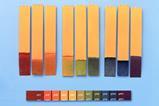Working through previous exam questions is a useful revision tool, but they offer much more potential for students to develop deeper cognitive skills

Past papers are an important tool for revision, allowing students to check how their revision is going and assess areas for improvement. Just doing the questions, perhaps under timed conditions and consulting the mark scheme is useful. However, too much of this can lead students to overemphasise the role of the mark scheme in their success and lead them to place lesser value on other types of homework and revision.
Often students resort to just going through the motions with past papers, because they aren’t sure what other independent work they can do. Here are ten learning activities to do with past papers that also develop the deeper cognitive skills vital for successful chemistry students.
1. Develop vocabulary
List all the formulas given in the paper and attempt to name all the chemical substances.
This develops the use of scientific vocabulary and accurate and automatic translation between formulas and systematic and common names.
2. Unit conversion
List all the quantities and measurements given in the paper (eg temperature readings, masses). Convert them to SI units.
This will develop students’ skills in mathematical reasoning and manipulation of formulas.
3. Equation practice
Past papers will often describe a process in words. Write balanced equations for all the processes mentioned.
Practising writing equations from text helps to prevent students throwing away easy marks when tackling these under pressure.
4. Drawing structures
Copy all the organic structures given in a paper. For each one, write out its different representations to give the skeletal, displayed and structural formulas.
This helps to practise switching between different representations of substances, meaning students are less likely to make silly errors such as drawing five-valent carbons in a test situation.
5. Revise bonding and properties
Carry out a brain-dumping exercise. For each of the substances given in a paper, write bullet points for everything you know about that substance. Start with the basics like physical and chemical properties and bonding.
If students don’t know very much about a substance mentioned, encourage them to revisit their notes.
6. Structuring longer answers
Look at the questions with higher mark allocations (eg six-mark questions). Write a first answer, using notes if necessary. Then rewrite that answer in bullet points or a flow chart. Compare with the mark scheme. Use a black marker to remove irrelevant words, then rewrite the answer.
This will help students write succinct answers using scientific language and to avoid repetition (which wastes time) and contradiction (which may lose marks).
7. State symbols
For each reaction mentioned in a paper, annotate the process with the physical states of the reactants and products and the observations during the reaction.
This helps develop a chemical common sense, relating the symbolic representation of a process with the macroscopic domain; what is seen in a test tube or flask.
8. Scaffolding maths questions
For each calculation question, write a flow chart of the mathematical processes needed to get the answer.
This helps students evaluate how well they understand the mathematical steps taken in calculation questions, meaning they are better able to deal with unfamiliar or less scaffolded questions should they come up in a test.
To help students sequence long mathematical processes, read Nine tips for scaffolding multi-step calculations.
9. Make concepts stick
Make pictorial representations of the processes listed in the paper.
Dual coding is a method of studying where words and visuals are combined. Cognitive science has shown it to be a powerful study technique that helps concepts stick.
10. Discount the distractors
In multiple choice questions there is one correct answer and a number of incorrect answers which are designed as distractors. For each multiple choice question, find the correct answer and then write a sentence for each of the incorrect answers to explain why they are incorrect.
This encourages students to consider distractors when completing MCQs, so they are aware of them under test conditions.














3 readers' comments